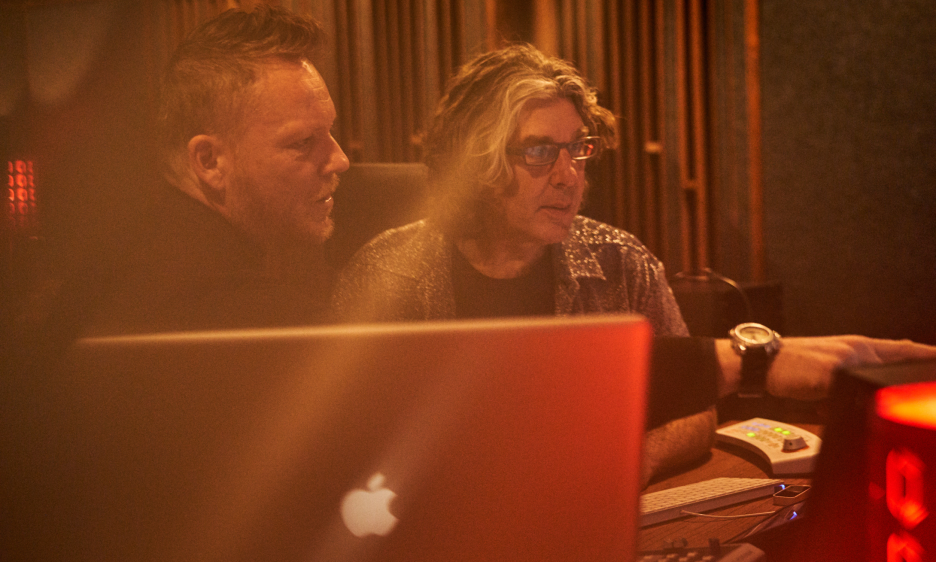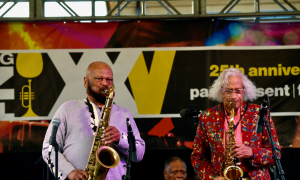Home » Jazz Articles » SoCal Jazz » Dolby ATMOS: Now HEAR This
Dolby ATMOS: Now HEAR This

Courtesy Peter Heck
What ATMOS does is to pull you into the experience quicker and more viscerally than a stereo mix because the sound is all around you. You are really in the experience.
—Karma Auger
All About Jazz: I had listened to Flying Spirits some six or seven times in a regular stereo mix, not in ATMOS, and was taken by just how spacious the recording is. There are several instruments in play and it sounded as if you could have doubled that and it still would have sounded incredibly open. Mind you, this was without even being cognizant of it being recorded in ATMOS. So it wasn't as if there was some sort of suggestive mental change to how I was hearing it. Interesting how recording in ATMOS has that much effect even when not listening in ATMOS.
Erich Gobel: Yes, well, a major part of the ATMOS process is the spacial coding. From the beginning Dolby was invested in immersive sound. The idea being to have sound coming from more places. In the ATMOS experience, as you have now heard, Dolby has made a major jump that includes height elevation speakers, literally coming from everywhere.
AAJ: That's for sure. Sitting in the prime position, completely engulfed in twelve speakers, each funneling a different track or instrument, here in your studio, is astounding. This is well beyond simply a cool listening experience. This completely changes the way you hear the music. I don't believe it is overstated to say that this is revolutionary.
Karma Auger: It absolutely is revolutionary. The major element of change is that Dolby ATMOS is mixed in a 3D space. Sound becomes an object within that 3D space that can be placed anywhere instead of to a particular speaker.
AAJ: This is way beyond the limitations of left and right channels.
KA: Yes it is, and Dolby ATMOS has been present in the film industry for eight or nine years now. While there are others using this technology, as always Dolby is leading the way.
AAJ: Surround sound has enhanced movie theaters for several decades now. However, bumping up from four to twelve separate channels is an impactful addition to the whole movie experience.
KA: If you speak with directors or most anyone in the industry they will tell you that sound is eighty to ninety percent of the emotional experience. To make that even more compelling and for it to have a visceral, direct, rubber hits the road connection with people, takes the experience to a whole new level.
AAJ: Despite the initial costs of upgrading theaters to ATMOS capabilities, it would seem to be the financially prudent action in the long run.
KA: Yes, Cinemark and the other major theater companies have all upgraded some of their theaters, with more to come. It also expands the possibilities. For example, there is a theater in a Santa Monica mall in which a music producer suggested bringing in live bands to perform. An option that presents itself once you have the ATMOS capabilities. What's really exciting, Jim, is that everything is going to ATMOS. Music, movies, video games, streaming, everything is exploding into ATMOS all at the same time. This is truly the next big thing in sound...everywhere! Quadraphonic came into play many years ago, but never came close to replacing stereo as the standard. ATMOS, on the other hand, is a game changer. People throughout the industry are excited and all saying that this is here to stay. That this is the largest leap in the industry since mono to stereo. The CEO of Apple has stated that the immersive sound of ATMOS is the most significant aspect of their new launch.
AAJ: "The largest leap in the industry since mono to stereo." That's a bold statement. However, having heard the difference it makes, I would wholeheartedly agree. The twenty-first century technology age has brought stunning advances to many industries, yet music had remained mostly stagnant, until now.
KA: Pink Floyd has long had one of the coolest most amazing live show, but imagine that with the sounds flying all over the theater or stadium.
EG: Yeah it would be great to see a show with a live band at the cinema with speakers and sound all over the place. It would be fantastic. Those kind of rooms usually sound really good to begin with.
AAJ: Wow, yeah, I hadn't thought of that. That's a very tangible example of what ATMOS can do. That it can take something as dense and rich as Pink Floyd and bring such a broad impact to the experience. You are hearing it so differently that in many ways it's like hearing it for the first time. That's how I felt listening to Flying Spirits. Hearing it in twelve channels with twelve speakers is not only compelling, as we have already said, but it changes the way you hear melodies, harmonies, and rhythms. With a jazz fusion record such as this it alters the way in which you hear and engage with the musician's conversation. I imagine there are any number of audiophiles that are going to rush out and install twelve speakers in the proper alignment, as you have here at Studio1LA, but most won't go to that extreme. Perhaps you could talk about the best way to enjoy the benefits of ATMOS without going to that level.
EG: Well, one of the best features of ATMOS is that it is scalable. It decodes at the consumer level, meaning that whatever device the consumer is listening on will be figured out by ATMOS and played in the appropriate format. ATMOS is scalable to 5.1 or 7.1, whatever speaker configuration one might have in their home theater. It also has binaural metadata that decodes into headphones. That places the spacial encoding into your headphones If you are listening on Apple or Itunes, and there is an ATMOS version of the song or record you are listening to, it will automatically decode the file to your type of headphones.
AAJ: I had read that certain headphones were required in order to receive the ATMOS sound. What you are saying, Erich, would seem to contradict that.
EG: Yes, you can use any headphones. Now there are some new headphones such as the Apple Air Pods and some others made by Sony that are made with immersive sound in mind. But it actually works great with any set of headphones. Just use your favorite headphones and there it is.
AAJ: Having two of the top engineers in the recording business talk about ATMOS would likely be sufficient, however a point of view from another perspective can surely be welcomed. Haslip produced Flying Spirits and played bass on the record. In addition to Budjana and Meier the band also included drummer Asaf Sikis and flautist Saat Syah. Jimmy, maybe you can talk about working with ATMOS from your perspective.
Jimmy Haslip: Well, this was an interesting situation, Jim. Karma and Erich had approached me about doing one song in ATMOS. Then they ended up doing the whole record in ATMOS, which blew me away that they did that. When they asked me to come in and listen to it, it was the first time I had heard anything in ATMOS and again I was blown away. At the same time they were asking me for comments about the mix or if anything needed to be changed. With that I needed to listen to the mixes subjectively and, hopefully, make intelligent comments about what I was hearing. All the while still just absolutely blown away by the technology. The changes were very minimal. If something could be made a little louder or to move something from one place to another. Just tiny little changes because what they had done was so awesome.
AAJ: These songs, then, were recorded with no thought of ATMOS in mind. It later developed into that. What about your upcoming fusion compilation record, when ATMOS is on the table from the beginning? Does it alter the process?
JH: Not at first. Not until I hear the mixes. Afterwards, in retrospect, I can ask myself what can I do with this in ATMOS. I thought about each of the eleven songs and what this technology could do for them. I handpicked these eleven songs and presented them to Karma and Erich for ATMOS consideration. If either of them had said they didn't like a particular song or thought that ATMOS wouldn't be beneficial to it, then I would take that into serious consideration. As it has turned out, so far everything I have sent is something Karma and Erich have been happy to jump in and start working on.
AAJ: So there could be a good song in a given situation that just doesn't lend itself towards benefiting from ATMOS.
JH: That's exactly right. It may be too simplistic or just not have enough going on to be enhanced by ATMOS.
KA: Well, Jimmy makes our job a lot easier in that everything he chooses is great. Let's face it, we are working with a very experienced musical genius. If you have ever seen Jimmy play music then you know how much he loves it and has fun with it. ATMOS is an all new playground for Jimmy to have fun with. We are helping him achieve that fun, which is a huge honor for us. It's a pleasure to be involved in all of his projects.
JH: Well, that's very kind to say that.
AAJ: Having seen Jimmy play live many times, I surely understand and agree with the pure joy, love of music, and intensity involved in his playing. I'm looking forward to seeing you with Oz Noy and Keith Carlock at the Baked Potato in August.
JH: The BP, yeah, that should be fun.
AAJ: On that, a trio is much less likely to need or utilize ATMOS.
JH: Right, yeah. Say you have a string bass, drums, and a guitar. There's not much there to work with in that sense. On the other hand, Karma and Erich are incredibly creative and would probably come up with something. But as a rule you are looking for music with more complexities. More pallets to work off of.
EG: Some music just wants to be static and not immersive, or move in a lot of directions. Jimmy is really good at picking music that is bold and wants to fly around the room.
KA: The interesting thing though too is that the less instruments that you have, the more space you have to put them in and move them through. The way ATMOS works is to move through space. So if the space is full with other instruments it can be difficult to move through it. It can get muddy or you need to make other adjustments. There's more to it. There are many options on the table. That's kind of the beauty of it. I personally think that all music sounds better in ATMOS. With the trio you put the drums up front with the bass behind, and the guitar moving around to the left, to the right, and all over. It's the idea of hearing it in 3D as opposed to 2D. I haven't heard any music suffer from moving into ATMOS.
AAJ: I would imagine not.
JH: Yeah, I think that there is certain music that really lends itself to ATMOS, but I agree with what Karma is saying that all music can likely benefit from being mixed in ATMOS.
KA: Well, Jimmy also brought us a project that is a bluegrass band. Most of what we did with that was to kind of keep things relatively static. There weren't that many instruments, yet we thought it was incredible at how great it lended itself to the format.
JH: Two of the fellas from the band came over, and heard it and were completely blown away.
KA: What ATMOS does is to pull you in to the music experience quicker and more viscerally than a stereo mix because the sound is all around you. You are really in the experience.
JH: Funny enough I am going to experience an ATMOS type of experience going to a Van Gogh exhibit at the L.A. County Museum. It's a 3D experience where you actually step in to the painting.
AAJ: Wow!
KA; Killer!
EG: Whoa!
JH: Yeah, that brought me to the idea of what if you had a record, such as Flying Spirits and you brought in an artist to paint to the music and then have an exhibit where people can step into it while listening to the music in ATMOS.
EG: What a great idea.
JH: I think we might explode from that experience (laughing).
EG: We are definitely heading into virtual reality and augmented reality in music, arts, film, really everything. Blending it all together.
JH: Well I've noticed over the years that whenever there is any kind of light show that it just makes the music a little more interesting. There are things changing in your immediate environment. So you add in the 3D and it takes it to a whole other dimension.
KA: I just had a thought. What if you bought a ticket virtually for a gig at the Baked Potato and are in St. Louis watching it. You are able to put on your virtual reality goggles and your earbuds and you are sitting inside the Baked Potato. I can move around inside and sit closer to the drums or closer to the bass or sit on the side of the keyboards, really anywhere I want to be. I can turn my head from one side to the other and the sound will then be coming from that direction. If I can't be there live then the next best thing is going to be this crazy virtual reality augmented reality show.
AAJ: That would be amazing! A serious upgrade from streaming, which is okay but really not any different than playing a DVD. It doesn't give you the feeling of being there.
JH: That's exactly right.
KA: That's the direction we are heading and we are very excited about it.
EG: Yes, and things are happening so rapidly. Things are all of a sudden just there! Here we were just talking about Dolby ATMOS a year ago and two weeks ago it shows up on my Iphone. That happened pretty quick.
KA: Apple deserves credit for having the foresight to see that ATMOS is the future and for jumping on it first. Right now ATMOS is available only on Apple. But Spotify, who have been the leaders in the industry, and everyone else will have it before very long. Apple is promoting it heavily on television, really all over the place, smartly trying to grab as many users as they can before the competition comes in.
AAJ: One thing I was interested in was the possibility of recording classic works of the past in ATMOS. My first thought was that it was unlikely, but then I saw that Apple has The Beatles Sergeant Pepper's Lonely Hearts Club Band (Parlophone, 1967) in ATMOS. That's really amazing.
EG: Yes, that's true. They did that at Abbey Road. I don't know exactly how they did that, but they were dealing with likely a couple of four-tracks.They were able to spread it out and, yeah, it is really amazing what is being done and so much more that we will continue to do. I heard "Come Together" in ATMOS and it is incredible.
KA: Yeah, it's really great.
EG: It's like hearing it again for the first time.
KA: It's just a whole other experience of a song that you know and love.
JH: That's insane. It's like hearing the song for the first time.
KA: Yeah, and to piggyback on what Erich was saying is that Universal has worked with Capitol Records, Abbey Road, Blackbird Studios in Nashville, and a bunch of studios around the world. They have put in Dolby ATMOS studios to mix their catalogs exactly for this purpose. To blow everybody's mind and to hear all this music that we all know and love and know every single note of into a unique new medium. Warner has also mixed a lot of their back catalogs into ATMOS. It's very exciting. I mean don't we all want to hear all this music in this way?
AAJ: I sure do.
JH: I would love to.
KA: It reminds me of when Technicolor first came in and they were able to color old movies and do all this really cool stuff. To me it's like that. Being able to bring classic work from the past into a modern world and enjoying it in a whole new way.
EG: You know too, even if you can't afford or don't want to invest in having twelve speakers in your house, you not only can listen through your headphones, but they are soon going to put it in cars. So you will have your own ATMOS studio that will come stock with your car.
KA: Yes, they are working with companies in Germany and Japan and elsewhere around the world. They are working with an electric car company called Lucid.
AAJ: That is way cool. Just to think about hearing The Dark Side of the Moon (Abbey Road, 1967) in ATMOS is mind-blowing.
JH: Oh yeah. And what about Jimi Hendrix Axis:Bold As Love (Reprise, 1967)? We could probably think of twenty thousand records to be heard over again in ATMOS.
AAJ: For sure. So many great jazz records as well.
JH: Yeah, I would love to hear Miles Smiles (Columbia, 1967) in ATMOS. That's a quintet but still would be amazing.
KA: It will sound like they are sitting in the room playing for you.
JH: Well too, if you think about it, the technology should lend itself to being heard all over your house coming out of every room.
KA: That technology is under way. They have sound bars for television that you can screen with Bluetooth. There are wireless speakers that connect and link with each other from room to room. So much is already here and so much more is right around the corner.
JH: It's mind boggling.
AAJ: This conversation has been mind boggling. Karma and Erich, I know you are deeply involved in this technology. How do you best describe what your mission is at Studio1LA?
EG: We are deeply involved in the craft of immersive mixing. Mostly immersive music and a little bit of post production. We are exploring and expanding the boundaries of what is possible in new formats. We are super excited to work with people like Jimmy, who are embracing the format and see the potential. And we are having a blast doing it.
KA: I think exactly that. We also have a sister studio called West Triad. That is actually Erich's studio, which is just a couple blocks away here in Venice (Los Angeles area). We do all kinds of recordings there. It has all the delicious analog stuff and a lot of great microphones. It's a great recording room. But as far as Studio1LA, we are an immersive mix room. We focus on the ATMOS experience and our excitement comes from being on the cutting edge. As Erich mentioned, working with people like Jimmy who are interested in doing something that hasn't been done yet.
AAJ: What has your working relationship with Dolby been like?
KA: Absolutely fantastic. Dolby has been so great about getting us anything we need. They are very supportive with any kind of challenge or issue we are facing. They are appreciative of the fact that we have embraced ATMOS wholeheartedly and with the resulting immersive productions.
AAJ: Well, it truly is the largest leap in music technology since the advent of stereo ushering mono out the door. This has been as much fun as it has been enlightening. Many thanks to all of you for a really outstanding conversation.
KA: Yeah, thank you, Jim. Thank you for your time.
EG: Thank you very much. Really glad you were able to come to our studio and appreciated the experience.
JH: I really enjoyed participating in this conversation with the three of you as well, and am really excited about the limitless future of Dolby ATMOS.
Tags
SoCal Jazz
Jimmy Haslip
Jim Worsley
United States
California
Los Angeles
Brian Auger
Dewa Budjana
Nicolas Meier
Jimmy Haslip
Asaf Sikis
Saat Syah
Oz Noy
Keith Carlock
The Beatles
Jimi Hendrix
PREVIOUS / NEXT
Support All About Jazz
 All About Jazz has been a pillar of jazz since 1995, championing it as an art form and, more importantly, supporting the musicians who make it. Our enduring commitment has made "AAJ" one of the most culturally important websites of its kind, read by hundreds of thousands of fans, musicians and industry figures every month.
All About Jazz has been a pillar of jazz since 1995, championing it as an art form and, more importantly, supporting the musicians who make it. Our enduring commitment has made "AAJ" one of the most culturally important websites of its kind, read by hundreds of thousands of fans, musicians and industry figures every month.























